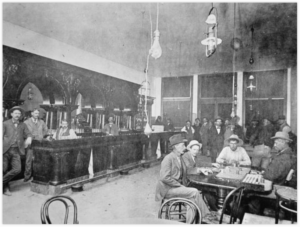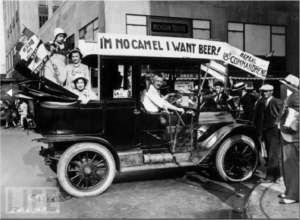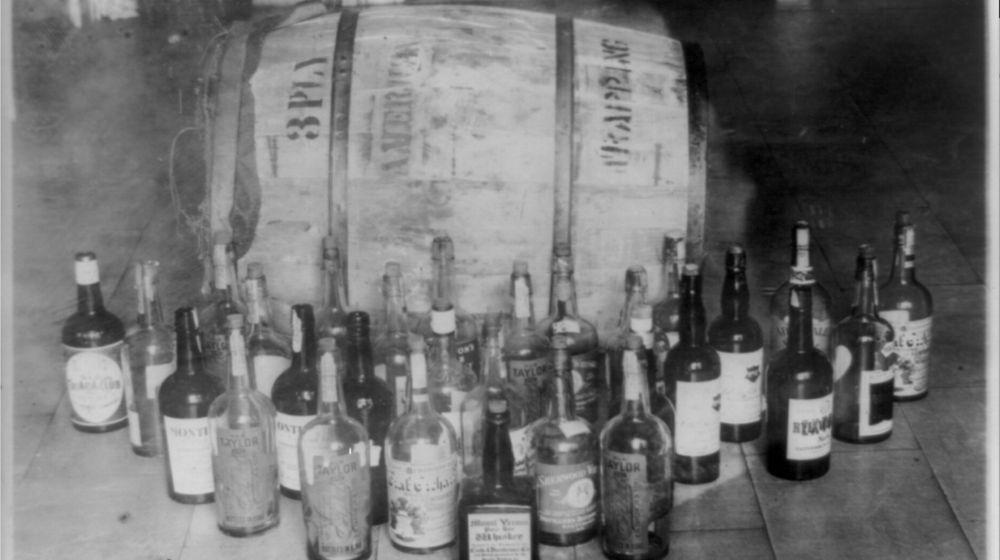Bottoms Up
Did you know…

Saloon c.1897, Jerome, AZ.
There has long been a tradition of drinking alcoholic beverages here in Arizona.
Ancient Native Americans here made fermented drinks out of corn (called tiswin), and the fruits of the pitahaya and prickly pear. Spanish missionaries brought grapes, wheat and barley to have some nice crusty bread and grape jelly – not! They brought it here to make wine and beer, of course. German immigrant, Alexander Levin, established the first commercial brewery in Arizona in 1864. And by the early 1880s, the Bagley brothers of Mesa built the first commercial winery in the territory.
When the railroad came to Arizona, trains brought cheaper beer, wine, and spirits to the region. That made things difficult for local brewers, vintners, and distillers, but many were still able to grow and prosper, until disaster struck in the form of a successful ballot initiative in November 1914. Arizonans had voted by a narrow margin to prohibit the sale, manufacture, and consumption of alcohol in the state. It was the thirteenth state to do so, five years before the national ban was enacted. Breweries, wineries, and distilleries had to close. They, as well as bars, restaurants, and stores, had to jettison whatever stock they had left by January 1, 1915.
Some businesses tried to diversify so they could stay in business. We know that Billie Gammel, who had purchased the Rosson House in 1914, tried to turn his bar, The Capital Saloon, into a soda shop. When that failed, the family turned to renting out rooms in their house to make ends meet. He also attempted ranching, and tried opening a bar in Mexico. It, too, failed. Other businesses (along with the All Saints Catholic Church of Tucson) tried taking the state to court, claiming the new law was unconstitutional, but their application was denied, and in 1916 Arizonans voted to keep prohibition by a 3 to 1 margin. In 1919, Congress passed the Volstead Act over President Wilson’s veto, and national prohibition was enacted.
Prohibition was here to stay. So everyone in Arizona and across the nation gave up on alcohol and abided by all new state and national laws, drinking only lemonade and iced tea, and boosted the economy by spending their money on their homes and families instead of alcohol. Everyone lived Happily Ever After…
…
…
Only they didn’t.
 Followers of the temperance movement touted the prohibition of alcohol as the answer to all of society’s ills. Poverty and malnutrition, “familial discord” (otherwise known as domestic violence), robberies, murder and more – they traced it all back to alcohol, and claimed that if alcohol was banned, it would all change for the better. Men would go home and spend time with their families instead of getting drunk at the bar, feeding their “violent tendencies”. They could then spend their hard earned money buying food and clothing for their wives and children, their wives could stay at home and focus on being “good and proper” wives and mothers instead of being “forced” to work outside the home, and everyone could turn over whole trees of new leaves, all due to this “Noble Experiment,” as Prohibition was often called.
Followers of the temperance movement touted the prohibition of alcohol as the answer to all of society’s ills. Poverty and malnutrition, “familial discord” (otherwise known as domestic violence), robberies, murder and more – they traced it all back to alcohol, and claimed that if alcohol was banned, it would all change for the better. Men would go home and spend time with their families instead of getting drunk at the bar, feeding their “violent tendencies”. They could then spend their hard earned money buying food and clothing for their wives and children, their wives could stay at home and focus on being “good and proper” wives and mothers instead of being “forced” to work outside the home, and everyone could turn over whole trees of new leaves, all due to this “Noble Experiment,” as Prohibition was often called.
When Prohibition was enacted, however, those things rarely, if ever, happened. People were still people, after all, with all their faults and flaws. And if people didn’t pay their mortgage and rent, treat their families well, or follow laws before Prohibition, they likely wouldn’t do any of that after, either. As Katherine Morrissey, Associate Professor of History, University of Arizona, said in The Dry Run: Prohibition in Arizona (AZ Public Media), people tended to view Prohibition like we see speed limits today. Honestly, you’d be pressed to find anyone who hasn’t pushed their car above the posted speed limit. Except for all of us at Heritage Square, of course. Ahem.
-
Fast Facts: Breaking the Law
Who was breaking Prohibition laws? Almost everyone.
- Billie and Frankie Gammel were fined $300 each for “disposing of intoxicating liquor.” Billie spent 10 days in jail, while Frankie’s jail sentence was deferred.
- Governor Hunt was rumored to have enjoyed a glass of “lemonade” on the Gammels’ front porch.
- Baron Goldwater (owner of Goldwater’s department store, and father of future Arizona conservative, Barry Goldwater), bought his favorite bar when prohibition was enacted, and moved everything (booze, bar, back bar, and the brass foot rail) to the basement of their house.
- Famous Washington DC bootlegger, George Cassiday, claimed that he sold alcohol to two thirds of the members of Congress.
- Oh, and pretty much everybody in Payson.
The Prohibition economy didn’t fare too well, either. Thousands of people lost their livelihoods when breweries, wineries, distilleries, and their associated wholesalers and retail stores went out of business, slashing tax revenues nationwide and harming an economy on the brink of the Great Depression. And if people were drinking illegally, they were also spending more money doing so. After Prohibition, liquor cost $4-$7 a gallon; during Prohibition, they spent the same or more on just a fourth of that amount that was usually of lesser quality, was watered down, and potentially poisonous.
 With so many people breaking the laws and spending much more money on alcohol, along with the rise of organized crime, it seems a wonder the 18th Amendment wasn’t repealed sooner than 1933. Though talk about changing the constitution went on for years prior, the 21st Amendment, created solely to repeal the 18th, was proposed in February 1933, and ratified on December 5th that same year. In the time between the two dates, Congress also passed a law that allowed beer and wine with 3.2% alcohol content to be sold in states that didn’t have a ban on alcohol. Arizona had repealed their state Prohibition laws in November 1932, and so some intoxicating beverages became legal to sell, ship, and consume when the new beer and wine law went into effect in April 1933.
With so many people breaking the laws and spending much more money on alcohol, along with the rise of organized crime, it seems a wonder the 18th Amendment wasn’t repealed sooner than 1933. Though talk about changing the constitution went on for years prior, the 21st Amendment, created solely to repeal the 18th, was proposed in February 1933, and ratified on December 5th that same year. In the time between the two dates, Congress also passed a law that allowed beer and wine with 3.2% alcohol content to be sold in states that didn’t have a ban on alcohol. Arizona had repealed their state Prohibition laws in November 1932, and so some intoxicating beverages became legal to sell, ship, and consume when the new beer and wine law went into effect in April 1933.
After the 21st Amendment was passed, the state of Arizona didn’t license anyone to sell liquor in the city of Phoenix until the City Council had new ordinances in place, just in time to celebrate the new year. Whew!
Information for today’s blog was gathered from: Sonora: A Description of the Province, Vol. 1, by Father Ignaz Pfefferkorn, 1794; Heritage Square blog, We’re No Angels, Take Two (April 2018); the AZ Wine Growers Assoc. webpage, the Phoenix New Times, Brewing Arizona, the PBS Ken Burns Prohibition series website, the Arizona Republic newspaper archive (November 1932 – December 1933), the Rim County Museum blog, and the AZ Public Media mini-documentary, The Dry Run: Prohibition in Arizona.
Check out The Mob Museum for more cool info about the Prohibition Era, and The Feast Podcast for fantastic episodes that talk about Prohibition, women, and Arizona cocktails.
